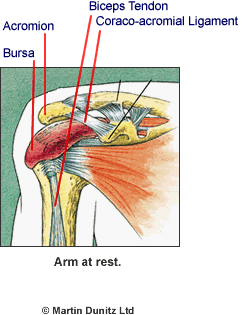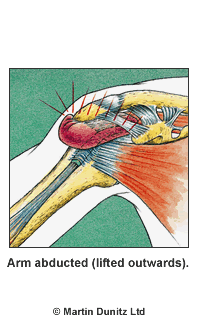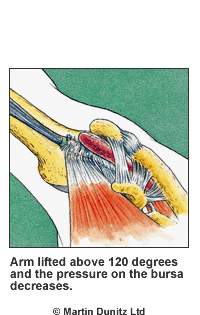| Common Signs & Symptoms | |||||
| Pain | Swelling | Stiffness | Weakness | Instability | Locking |
Shoulder Bursitis Injury Explained
Shoulder bursitis is a common cause of shoulder pain that is related to Rotator Cuff Tendonitis. Specifically, Shoulder Bursitis is inflammation of a structure called the ‘Subacromial bursa’. This condition is sometimes called Shoulder Impingement Syndrome and to understand how it occurs it is helpful to understand the anatomy of the shoulder.
The Subscapularis, Supraspinatus, Infraspinatus and Teres minor are small muscles that stabilise the shoulder. Collectively, these four muscles are known as the rotator cuff. Within the shoulder, bones and ligaments form an arch over the top of these rotator cuff muscles. In between the rotator cuff muscles and the arch is the Subacromial space, which is filled by the Subacromial bursa, a sac of fluid that is designed to prevent friction.



Because of its position, the Subacromial bursa can become irritated and inflamed during repeated overhead shoulder movements as a result of being continually squashed or ‘impinged’ between the muscles and the bone, Sometimes, because the bursa lies so close to the rotator cuff, it can become irritated and inflamed when the rotator cuff is injured.
Shoulder impingement is classified as primary or secondary, depending on the cause:
- Primary Impingement
Some people will have a naturally smaller space for the bursa, which is just bad luck, but the space can also be reduced by conditions such as Osteoarthritis. Whatever the cause of this small space, repetitive overhead activities (such as throwing a basketball or dusting high shelves) can cause the rotator cuff to become continuously squashed against the bone, causing inflammation of the cuff. - Secondary Impingement
Many people will have what is called shoulder instability (a lax shoulder joint). Often this will have occurred over time due to repetitive overhead activity, poor posture or inactivity. Due to this instability, the rotator cuff has to overwork to stabilise the shoulder, causing it to become inflamed. Eventually, the rotator cuff will become weak and tired, and will not be able to prevent the head of the Humerus (upper arm) from squashing up against the bone of the shoulder blade, thus squashing the bursa. Because this type of impingement is not due to a small Subacromial space for the bursa, it is called secondary impingement.
![]() Also see Rotator Cuff Injuries
Also see Rotator Cuff Injuries
Shoulder Bursitis usually comes on gradually, although occasionally a fall onto the affected shoulder can start things off. Typically, it is related to overdoing overhead activity that requires the arm to go up and down repeatedly. A weekend of home improvement or repeated sports activities such as tennis or volleyball in people who are not regular players, can be enough to trigger Shoulder Bursitis.
Shoulder Bursitis Signs & Symptoms
Shoulder bursitis is characterised by shoulder pain, and as a result there is often reduced range of movement. The pain is located over the tip of the shoulder and often it radiates down the arm. Activities such as washing hair and reaching up for the breakfast cereal in a high cupboard become very restricted due to shoulder pain. There is also shoulder pain at night in people who habitually sleep on the painful shoulder or those who sleep with the painful shoulder above their head.
Although it is possible for a physiotherapist to differentiate Shoulder Bursitis from a Rotator Cuff Injury using manual tests, this may be difficult because the two conditions tend to occur together. An ultrasound or MRI scan should reveal whether the subacromial bursa, rotator cuff, or both structures, are involved.
Shoulder Bursitis Treatment
What you can do
| Consult a sports injury expert | |
| Apply ice packs/cold therapy to relieve pain & reduce inflammation | |
| Use resistance bands for strengthening exercises | |
| Wear a shoulder support for reassurance |
Shoulder Bursitis that has just started can be improved with physiotherapy treatment, provided it is caught early enough. Chronic (long-term) Shoulder Bursitis is less likely to clear up with physiotherapy and a corticosteroid injection (an injection of a naturally occurring substance that can slow down inflammation) may be required.
The first priority of physiotherapy treatment is to reduce the pain and inflammation using ice therapy. Ice Packs can be applied for periods of twenty minutes every couple of hours (never apply ice directly to the skin as it can cause an ice burn). The Ice Packs relieve pain and reduce inflammation in the tissue. The Aircast Cryo/Cuff is the most effective method of providing ice therapy and can be used for the home treatment of shoulder injuries and shoulder pain. It can provide continuous ice cold water and compression for up to 8 hours and significantly reduce pain and inflammation.
Once the shoulder pain and inflammation have resolved, physiotherapy treatment is focused on exercises to restore shoulder range of movement, muscle strength and stability. Shoulder stability exercises involve very precise re-training of the movements of the shoulder blade under the supervision of a Chartered Physiotherapist. Stability exercises are practiced with minimal resistance at first, but Resistance Bands and Cords are ideal for improving shoulder stability. These exercises also play a key role in the prevention of shoulder problems.
Posture correction exercise will also be prescribed as lots of sitting, driving and computer work may cause a more rounded shape of the upper back and shoulders, which in turn reduces the space under the subacromial arch. Strengthening the muscles around the shoulder blades and taking regular breaks from sitting will help reduce pressure on the bursa.
Shoulder Bursitis Prevention
The key to preventing Shoulder Bursitis and rotator cuff problems is to address the problems of primary and secondary impingement. Where impingement is occurring, the space for the subacromial bursa is reduced. This space can be optimised by practicing shoulder stability exercises with a physiotherapist. These exercises concentrate on controlling the movement of the shoulder blade, by ensuring that muscle contract in the correct sequence during shoulder movements, to ensure that the ball of the upper arm remains stable in the shoulder socket during work, sport and functional activities.


